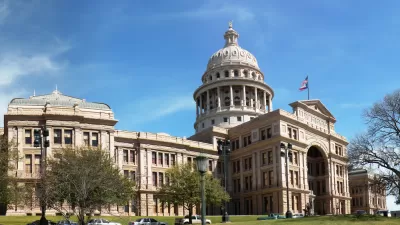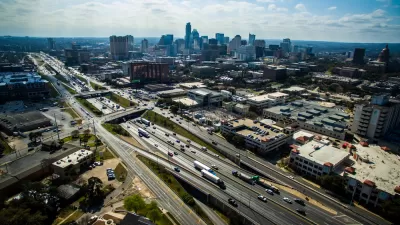A political decision by the Texas Transportation Commission last December to drop projects which included toll lanes was thought to doom 15 road expansions from their 10-year capital plan, but some will go forward with HOV as opposed to HOT lanes.

Last December, the Texas Transportation Commission, reacting to pressure from Gov. Greg Abbott and Lt. Gov. Dan Patrick to not spend funds from statewide propositions passed by voters in 2014 and 2015 on express lanes, voted 5-0 to eliminate 15 express lane projects from their 10-year capital plan. Neither ballot measures created new revenue. Instead, both divert existing funding streams (the state's Rainy Day Fund and sales taxes, respectively,) to roads and prohibit spending the revenue on toll lanes.
Ben Wear, who covers transportation for the Austin American-Statesman, reports that some projects will be expanded after all, though not as originally planned.
In a major departure from previously announced proposals, though, the $8.1 billion overhaul of I-35 through Central Texas would include the addition from Round Rock to Buda of nontolled managed lanes in each direction. In practice, that would mean high occupancy vehicle [HOV] lanes — sometimes referred to as carpool lanes — that only vehicles with at least two or perhaps three people aboard would be allowed to use.
The Texas Department of Transportation and local legislators had previously said the addition of lanes to I-35 would be possible financially only with tolls — and the borrowing that charging tolls allows. Now, TxDOT’s “unified transportation plan” [sic] for fiscal 2019 through fiscal 2028 assumes that the agency eventually will expand I-35 without charging tolls.
Motorists may be pleased to hear that "relief" is coming, but Wear reports that TxDOT lacks most of the funds. "How the agency will come up with the lion’s share of the I-35 project’s cost, and when, remains undetermined in this year’s version of the plan," he adds.
Implications beyond financing
Dropping the toll lanes, also known as express or TEXpress Lanes, means limiting access and forfeiting a valuable congestion management strategy. Depending on the roadway and time-of-day, carpools either received free or 50% discounted access to the toll lanes, also generically called high occupancy toll (HOT) lanes if they benefit carpoolers, which not all do.
Solo drivers can access the express lanes that utilize variable congestion-management pricing to ensure traffic speeds of at least 50 miles per hour. Solo drivers who access the carpool lanes risk a hefty fine, and the carpool lane itself will lack the management provided by dynamic tolling.
Extra revenue
TxDOT, "which had estimated it would get $770 million through Proposition 1 this year, instead will get about $1.3 billion, officials said, because of increasing oil prices and production," adds Wear.
Proposition 7 will direct state sales tax of $2.5 billion, a figure estimated to climb in the coming years, to TxDOT, and the agency now receives another $500 million or more each year in gasoline taxes that previously had been allocated to the Texas Department of Public Safety.
Another project Wear mentions is the U.S. 183 expansion in North Austin which would add two tolled lanes and one general purpose lane.
However, the plan now calls for the Central Texas Regional Mobility Authority to undertake the project on its own, with bonded debt.
Related posts:
-
Huge Toll Lane Setback in Texas: December 19, 2017In a landmark, unanimous vote, the Texas Transportation Commission eliminated all 15 express lane projects from their 10-year capital plan despite pleas from Austin area officials to retain the $8 billion, I-35 project that includes four toll lanes.
-
Interstate 35 through Central Austin would be transformed into a three-level roadway with toll lanes in the middle, according to an 8.1 billion vision proposed by TxDOT.
-
Big Expansion Approved for Austin-Area Highway: February 10, 2016The Transportation Policy Board of the Capital Area Metropolitan Planning Organization approved a big spending increase for a project to widen U.S. Highway 183.
Hat tip to IBTTA Smart Brief.
FULL STORY: TxDOT plan now foresees no tolls on I-35 expansion in Central Texas

Maui's Vacation Rental Debate Turns Ugly
Verbal attacks, misinformation campaigns and fistfights plague a high-stakes debate to convert thousands of vacation rentals into long-term housing.

Planetizen Federal Action Tracker
A weekly monitor of how Trump’s orders and actions are impacting planners and planning in America.

In Urban Planning, AI Prompting Could be the New Design Thinking
Creativity has long been key to great urban design. What if we see AI as our new creative partner?

King County Supportive Housing Program Offers Hope for Unhoused Residents
The county is taking a ‘Housing First’ approach that prioritizes getting people into housing, then offering wraparound supportive services.

Researchers Use AI to Get Clearer Picture of US Housing
Analysts are using artificial intelligence to supercharge their research by allowing them to comb through data faster. Though these AI tools can be error prone, they save time and housing researchers are optimistic about the future.

Making Shared Micromobility More Inclusive
Cities and shared mobility system operators can do more to include people with disabilities in planning and operations, per a new report.
Urban Design for Planners 1: Software Tools
This six-course series explores essential urban design concepts using open source software and equips planners with the tools they need to participate fully in the urban design process.
Planning for Universal Design
Learn the tools for implementing Universal Design in planning regulations.
planning NEXT
Appalachian Highlands Housing Partners
Mpact (founded as Rail~Volution)
City of Camden Redevelopment Agency
City of Astoria
City of Portland
City of Laramie




























